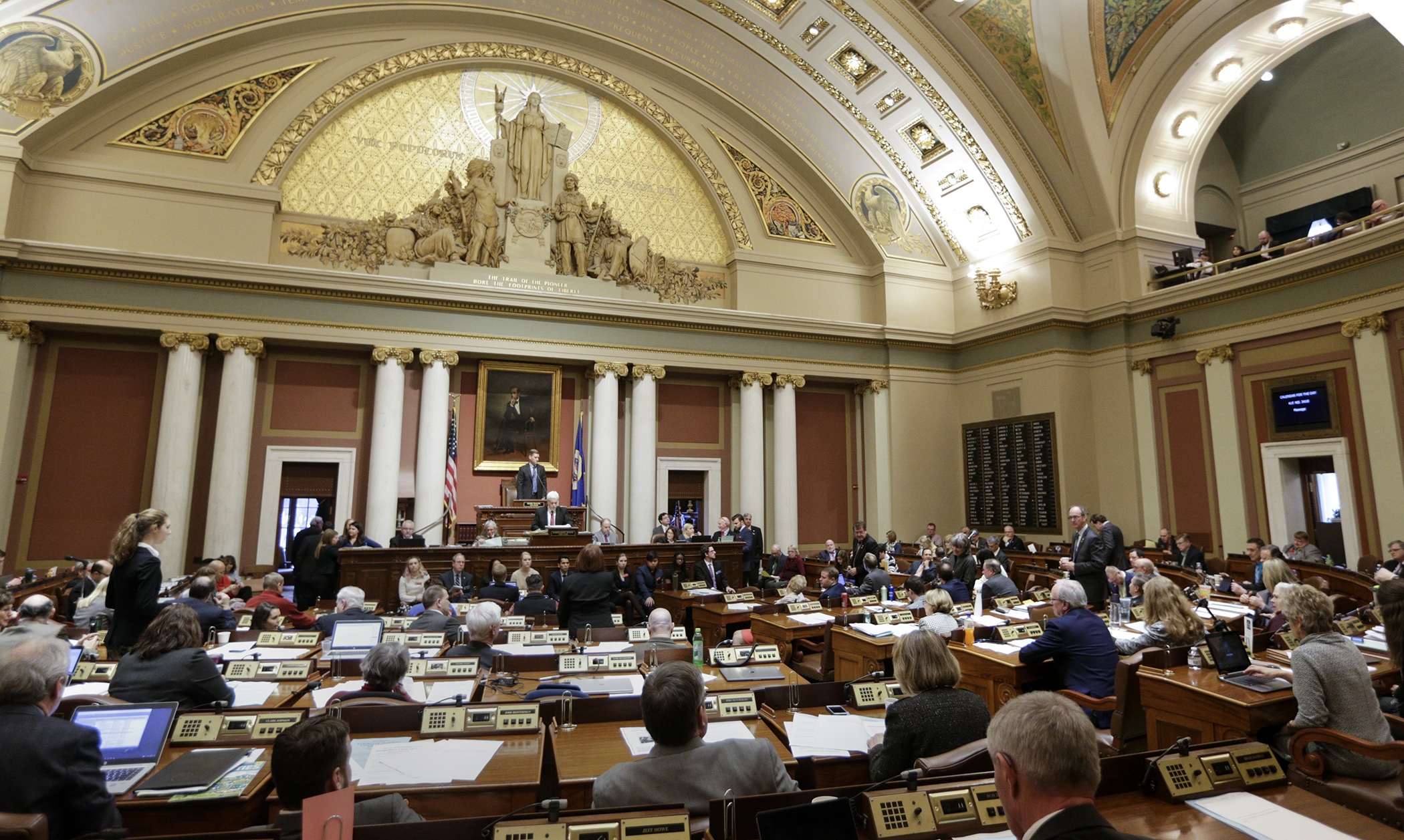Legislative process — and potential fixes — the focus of House hearings

(UPDATED to include Wednesday testimony)
Legislators need time to work on complex issues, but potential operating changes could reduce last-minute institutional chaos.
That was among the messages at a Tuesday night presentation by a national legislative expert to a group of state lawmakers.
Brenda Erickson, a program principal in the National Conference of State Legislature’s Legislative Management Program, offered ideas and shared procedures from other states during the first of two informational meetings on ways to potentially reform Minnesota’s lawmaking process.
Public and stakeholder testimony occurred Wednesday.
Some have blamed the Legislature’s recent struggles to finish its work on so-called “Washington D.C.-style politics.” Others remain critical about a lack of transparency and openness, with many agreements reached out of public view.
Call it what you want, but Rep. Gene Pelowski, Jr. (DFL-Winona) wants to see things like compromise and bipartisanship become more than just buzzwords.
Recently elected to his 17th term, Pelowski has for many years been looking at ways to ensure a more fair, open and efficient process. With the DFL winning the House majority for the 2019-20 biennium, he hopes some changes can occur.
“There will be some consideration of changes in the Minnesota House,” Pelowski said, adding a subcommittee of the House Rules and Legislative Administration Committee plans to delve deeper into the issue.
Problems go back a few months, years
Over the past decade, Pelowski said, the Legislature’s performance “has been less than stellar.”
The 2018 legislative session finished with many unresolved policy and fiscal issues across numerous topics.
After a lack of back-and-forth, but plenty of posturing by both sides of the aisle, Republican leaders chose to push through a nearly 1,000 page so-called “omnibus-omnibus bill” covering myriad funding and policy areas.
Less than eight hours after being posted online —and fewer than 22 hours before adjournment — the proposal was passed with members unaware in total of what they were voting for or against.
“There was no way this evening that I could go through that bill,” Rep. Lyndon Carlson Sr. (DFL-Crystal) said at the time.
The all-encompassing proposal was vetoed by Gov. Mark Dayton, who a few days earlier said the session was in “shambles."
The events of last May were just the latest unsuccessful attempts at smooth legislating.
Some people would argue the basis of the problem is not only differing views on policy and fiscal matters between Republicans in charge of the House and Senate and the governor, whom House Speaker Kurt Daudt (R-Crown) accused of not being “engaged” during the session or final budget negotiations, but an unwillingness to work together.
House Speaker-designate Melissa Hortman (DFL-Brooklyn Park) said at the time Republicans didn’t show “any aptitude at all in listening to the governor or compromising with the governor.”
The 2018 session was the latest in which the Legislature was often criticized by people inside and outside for process problems:
- eight of the 10 major spending bills made it through the Legislature during the last day of the 2015 session;
- the 2011 session ended without a budget agreement that led to a partial state government shutdown;
- the DFL-led Legislature of 2008 created an all-in-one supplemental finance bill, sponsored by Carlson; and
- the 2007 session ended with shouting about procedural provisions as a tax bill was passed. [Watch]
Emphasizing that there is no exact science to lawmaking, Erickson provided examples of what has strengthened other states’ practices, including limits on how many committees on which a member can serve; prohibiting bills that have been defeated — or bills substantially the same as defeated ones — from being reintroduced as a bill or amendment during the same biennium; allowing the Legislature to call itself into special session; bill introduction limits per member; and bill introduction deadlines.
She said an average legislature introduces just under 2,200 bills per year; in Minnesota it’s just over 3,500. New York averages about 16,000 bills per year, while Colorado introduces on average just a few hundred because of limits on bill introductions.
“Many chambers have experimented with ways to curb the amount of legislation that enters the process,” Erickson said. “The most direct approach is to set a numerical limit on bill introductions.”
Rep. Mike Freiberg (DFL-Golden Valley) noted Minnesota has one of the largest legislatures, and wondered about bills per member across the country. Erickson said she had not calculated that.
‘Come full circle’
John Kaul, a long-time lobbyist who has been involved with the Legislature in one way or another for nearly 50 years, said Wednesday things have now almost come full circle to the way business was conducted in the early 1970s, when much of the work was done behind closed doors.
“Why, if we’re doing what the public wants, have we moved so much of the process out of the public view?” Kaul said.
He said that despite all the disagreements members had when he first began working at the Legislature, all sides would agree that though they may not have gotten all they wanted they’d at least moved the state forward.
But Rep.-elect Ryan Winkler (DFL-Golden Valley), chosen to be the next majority leader, said the political landscape is more polarized today and that many politicians are afraid to pay the price that comes with compromise. He said more progress might be made if lawmakers forged better relationships with one another, rather than rules changes.
“I think it rests with us as legislators not necessarily with changes in rules or laws to address the situation as it is,” Winkler said.
Other problems mentioned during Wednesday’s meeting include:
- closed-door negotiations out of the public eye;
- conference committees that concentrate power in the hands of the very few;
- influence of special interests;
- lack of notice for committee hearings;
- gamesmanship on the House Floor by questioning germaneness of amendments or debate in order to avoid having to take action;
- delete-all amendments that make major changes to bills;
- unrealistic meeting agendas with too many bills scheduled and/or not enough time to fully consider and debate bills;
- unenforced deadlines for committees to complete their work; and
- fiscal notes ignored or fiscal bills passed without them.
Potential solutions discussed include:
- House Floor votes on the financial targets used to create the various budget bills to provide more transparency and input;
- requiring conference committee negotiations and offers to take place in public;
- deadlines for conference committees to finish their work;
- not appointing a conference committee immediately if the House and Senate versions of a bill don’t agree, instead allowing more time to reach agreements; and
- subcommittees of three or five members, which it was suggested can sometimes make it easier to get past party affiliations and find compromise and solutions.
Persistent Pelowski
This is not Pelowski’s first crack at reform.
Ten years ago, the House Governmental Operations, Reform, Technology and Elections Committee, which Pelowski chaired, agreed to submit a document to legislative leaders, with a recommendation that the 2009 Legislature consider some of the changes. “The changes in this report come from ideas suggested from a variety of sources: House members, lobbyists and members of the public,” it states.
Among the recommendations:
- House and Senate committees with similar jurisdiction should facilitate joint hearings;
- all committees should have jurisdiction over both policy and finance matters;
- members should be permitted to designate one or more bills as priority bills, with a requirement that committees vote on them, provided there is a Senate companion;
- time limits on debate, and limiting the number of times a member can speak on an issue;
- bills should be taken up in the order published on a calendar; and
- prohibiting the House from meeting after midnight.
The recommendations also suggest that conference committees meet at times that would encourage more public participation, and conferees do all their work in public instead of emerging from behind closed doors saying a deal has been reached.
-- House Public Information Services Assistant Editor Jon Mohr contributed to this story.
Related Articles
Search Session Daily
Advanced Search OptionsPriority Dailies
Ways and Means Committee OKs proposed $512 million supplemental budget on party-line vote
By Mike Cook Meeting more needs or fiscal irresponsibility is one way to sum up the differences among the two parties on a supplemental spending package a year after a $72 billion state budg...
Meeting more needs or fiscal irresponsibility is one way to sum up the differences among the two parties on a supplemental spending package a year after a $72 billion state budg...
Minnesota’s projected budget surplus balloons to $3.7 billion, but fiscal pressure still looms
By Rob Hubbard Just as Minnesota has experienced a warmer winter than usual, so has the state’s budget outlook warmed over the past few months.
On Thursday, Minnesota Management and Budget...
Just as Minnesota has experienced a warmer winter than usual, so has the state’s budget outlook warmed over the past few months.
On Thursday, Minnesota Management and Budget...
